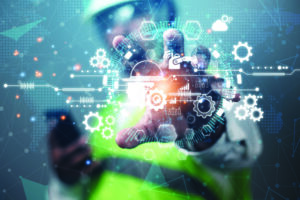
Applications for AI in Construction
By David Bowcott
Construction Risk ManagementIs your organization’s “data house” in order so that you can deploy AI solutions?
The return on investment from identifying, structuring and linking the data in your organization may represent the best investment your business could make. We are witnessing the birth of Artificial Intelligence (AI) in both narrow and general form, and when connected to a well-organized, interconnected and accurate data set, its potential applications are plentiful and highly beneficial.
Artificial intelligence is the simulation of human intelligence. It learns from experience, self-corrects, harnesses reason and overall evolves its intelligence. AI can be both narrow, where it is use for specific tasks, but more recently it is becoming general, whereby it simulates the cognitive abilities of human beings (intelligence on a variety of tasks and subjects).
With the level of attention AI is receiving, you know that there are construction applications, many that are just starting to garner attention. Here are a few ways it may be used within the construction sector.
ENTERPRISE INTELLIGENCE AI
A small group of the more progressive construction stakeholders are taking measures to identify, organize, structure and link their organization’s data. By doing so they will be in a position to allow organizational- wide queries by their staff, and potentially their clients, to identify a path to the right decision.
Imagine a company specific ChatGPT that provides answers to questions like, “Who should I talk to about my health benefits?” or, “What are some of the best practices I should consider when working on sections of a hospital project that have MRI equipment?.” The richest source of data for such an AI solution is likely your enterprise management software (for a contractor it could be their project management software).
CONTRACT REVIEW AI
There are a few construction-focused technologies that allow for the more efficient review of design documentation and construction contracts. You can even see demos of ChatGPT performing contract reviews with high levels of efficiency and accuracy. These technologies are being trained to identify the levels of risk-taking via these documentation sets, thus providing the construction sector a much more efficient and accurate way to assess risk allocation via contract.
INTERNET OF THINGS (IOT) AI
As the IoT universe continues to expand and gains widespread use in both the construction phase and the operations phase of a built asset, the interlinking of IoT devices via an IoT backbone will create tremendous AI opportunities. Imagine an AI that sits overtop of all this data. It is like having a project brain that is feed by sensors (or senses) via interconnectivity (or a backbone). Such AI is already being developed and is learning how devices like environmental sensors can predict risks of pipe burst due to temperature change.
REALITY CAPTURE AI
Some of the more progressive construction stakeholders are using jobsite scanning technology and other forms of computer vision to keep regular tabs on their jobsites and as-built progress. AI is being integrated into these computer vision applications to identify things like unsafe areas on the projects, defective workmanship and progress of various subtrades on the project. Such applications massively shorten the time previously taken by humans to inspect for safety, quality and progress.
COUNTER-PARTY RISK AI
The construction sector brings together many stakeholders to delivery a specific project on-time and on-budget. Monitoring the ability of all stakeholders to perform their contracts is a crucial risk control. There are companies that provide financial, business and safety assessments of the thousands of stakeholders within the construction community. Many of those companies are harnessing AI to determine which counter-party metrics are the best predictor of default.
SCHEDULING AI
Several applications in the scheduling technology sector are using AI to predict if schedules are achievable before construction begins, and to monitor schedule progress during the construction phase. Several of these applications harness other technologies on the project to validate progress (i.e., reality capture).
AI is already making transformational strides within the construction industry. These examples are but a few areas where AI is intermingling with other construction technology solutions to gain a previously unforeseen level of transparency into the construction jobsite. Further, AI isn’t only providing real-time updates on the project, it is providing predictive insights into the projects and identifying things that have a high likelihood of going wrong.
Risks are not only being mitigated, they are being prevented through the use of this ever-evolving intelligence partner.
Contractors that are not preparing their companies to harness the benefits of AI will likely soon find themselves at a substantial competitive advantage.
 David Bowcott is the managing director, construction, at NFP Corp. Please send comments to editor@on-sitemag.com.
David Bowcott is the managing director, construction, at NFP Corp. Please send comments to editor@on-sitemag.com.





